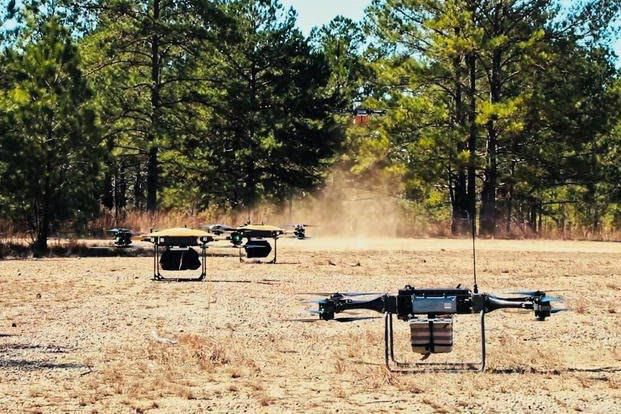[ad_1]
Lt. Gen. Michael “Erik” Kurilla, commander of XVIII Airborne Corps, officially endorsed battlefield drone resupply after successful demonstrations. During the recent Army Expeditionary Warrior Experiment (AEWE) 2021, a company-sized unit carried out a defensive action in which the defenders ran low on ammunition and two commercial drone flew a rapid resupply mission.

Quadcopters bring ammunition and water resupply during Army Expeditionary Warrior Experiment (AEWE) … [+]
Two types of drone were used, on carrying an 80-pound load, the other 150 pounds. Ammunition packs were made up in advance so that rather than detailing what they needed, the unit could just order “Package Two” to get a suitable mix of calibers.
A typical 80-pound load could include 400 rounds of belted ammunition for the M240 medium machinegun, plus 500 rounds for the M249 light machinegun , and another 500 to 600 rounds for M4A1s personal weapons. The larger payload could include over 2,000 rounds of 7.62mm. The drones can also carry other supplies such as five-gallon containers of water.
This type of rapid resupply could be even more valuable for an attacking situation, where troops are not able to stockpile ammunition.
“This is the notion that you can get supplies forward to prepare for counterattack or potentially press the attack,” Ed Davis, director of the Maneuver Battle Lab, told an audience March 9 debriefing event. “You want to end the attack on your terms, not necessarily because you need ammo.”
It took just three weeks of training for troops to learn how use the drones, including programming them with flight plans and attaching and detaching supply packages. That’s a lot quicker than learning to fly a helicopter . The drones only need a landing space about 25 feet square to land; during the exercise they dropped off supplies on rooftops and forest clearings to show how easily they could reach inaccessible locations.
The enthusiasm for the new drones suggests that the Army has found its sweet spot for payload size. When Amazon
At the other end of the scale, the Army successfully used the K-MAX unmanned cargo helicopter for resupply missions in Afghanistan. In 2012. Two Lockheed Martin K-MAX’s carried up to 4,300 pounds in one go, delivering over 750,000 pounds of supplies in 230 missions. However, these craft are as big and expensive as a manned helicopter – although far more expendable – and it seems the Army is looking for an asset that can be available at a company level.

Drone resupply in a 2017 U.S. Army exercise
The drones for the AEWE exercise were supplied by Bell Textron
Malloy Aeronautics produce two sizes of logistics drone , the T-80 and T-150, corresponding to the two sizes of payload. These are both multicopter designs with an endurance of more than half an hour and a range of more than 30 miles.
Bell’s Autonomous Pod Transport (APT) is a more innovative design. It is a ‘tail sitter’, taking off and landing vertically like a helicopter , then rotating 90 degrees and flying horizontally like an aircraft. This configuration is intended to give greater speed and longer range than pure multicopter designs. The APT 70 version carries 70 pounds to a distance of 35 miles at a maximum speed of over 120 mph. Cargo is carried in a detachable pod which is aerodynamic to reduce the drag in flight.
These medium-size drones appear to represent an ideal balance of simplicity and affordability with carrying a useful payload. They can be sent in to resupply units in a middle of a firefight, a situation far too hazardous for a manned resupply mission. If drones are lost, they are easily replaced.
After the exercise, XVIII Airborne Corps Commander Lt. Gen. Kurilla signed a memorandum of endorsement. It is not clear when the unit will receive logistics drones, but the concept appears to be gaining momentum.
“I don’t think it’s a matter of if the Army is going to go to these,” Capt. Chris Lapinsky, who commanded the unit in the exercise, told Military.com. “It’s going to happen.”
[ad_2]
